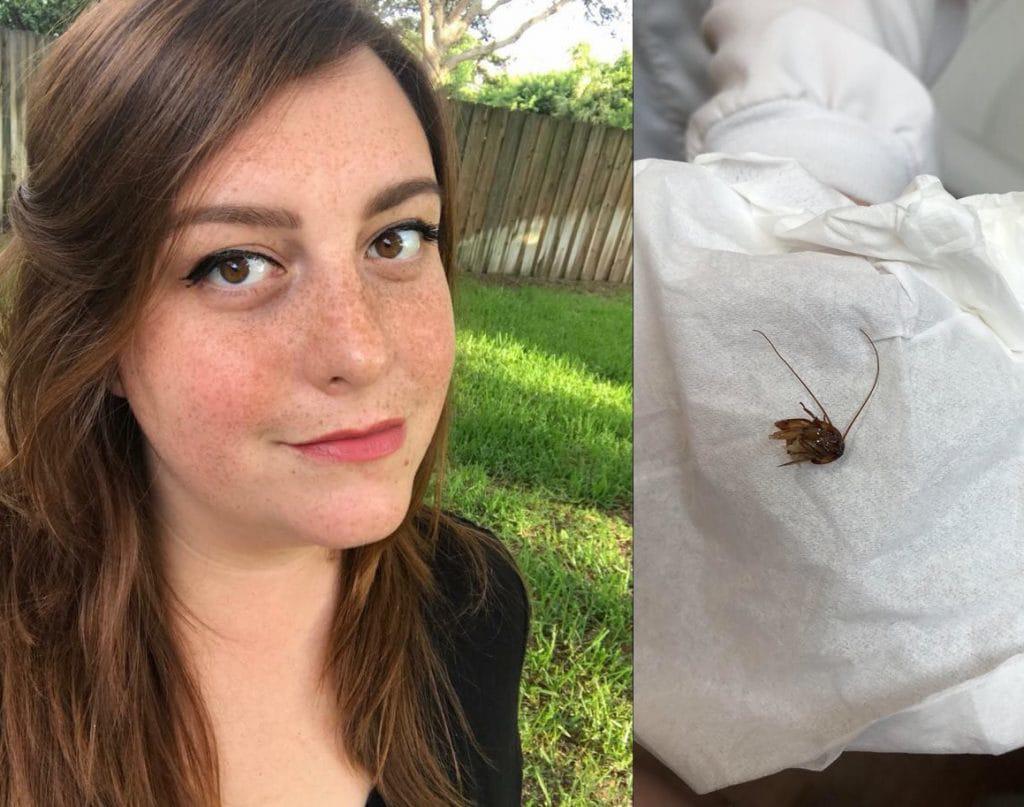Cockroach removed from woman’s ear canal after nine days: 'It was a roach. In my ear'
'Roaches are searching for food everywhere, and earwax might be appealing to them,' entomologist says

Katie Holley was jolted awake by a cold thing – what she had initially thought was a small piece of ice that somehow slid down her left ear. Still disoriented, she rushed to the bathroom, grabbed a cotton swab and slowly stuck it inside her ear. And then Ms Holley felt something move. It was like a “rhythmic” movement, she recalled, as whatever it was tried to burrow deeper into her ear canal.
She pulled out the cotton swab and saw small, dark brown pieces that looked like legs.
Cockroaches have been a nuisance in the Holley household since she and her husband, Jordan Holley, bought their first home last year, she wrote in Self magazine this week. They thrive in warm and damp places and that includes Florida, where the young couple live and where flying cockroaches called palmetto bugs are most common. Households in warm cities, such as New Orleans, Houston and Atlanta, report more problems with cockroaches than much of the country.
A few weeks earlier, an exterminator sprayed every room inside the couple’s house in Melbourne, Florida and Ms Holley felt what turned out to be a very temporary sense of relief.
That morning, around 1.45am on 14 April, Mr Holley rushed to the bathroom to help his panicking wife, grabbed a flashlight and looked inside her ear. And there it was, a small part still visible from the outside as it stayed there, lodged in the middle of the ear canal. Mr Holley managed to pull out a couple of legs using a pair of tweezers, but the intrepid bug had crawled too deep.
The young couple drove to the emergency room just a few miles away. A man sitting behind a desk near the hospital’s entrance saw the look of panic in Ms Holley’s face and asked whether she was in pain.
“A roach crawled into my ear while I was sleeping and it was stuck,” Ms Holley said she told him.
She was given a wristband and taken to a room, where she lay on her side on a gurney, whimpering. A nurse injected the bug with the anaesthetic lidocaine to try to kill it. Ms Holley said she felt the roach move, twitching and wriggling further into her ear as it tried to avoid death. Two minutes later, it stopped moving.
It took the doctor about 20 seconds to pull out chunks of the dead roach and Ms Holley saw what she thought was the remains of a small insect. She left the hospital nearly two hours later with a prescription for antibiotics and ear drops, relieved that it was all over. She and her husband vowed to never let the experience happen again, stopping by a Walmart to buy earplugs.
Nine days passed, but Ms Holley’s ear still did not feel normal. It was still numb, she said and she felt some discomfort every time she yawned. Her medicine drops also had stopped passing through her ear, leading her to think that perhaps earwax had built up inside.
She went to her physician for her regularly scheduled appointment and asked the doctor whether she could check her ear. Her doctor and a physician assistant flushed her ear four times. Using an otoscope, they peeked inside and there it was – another leg.
Ms Holley’s doctor pulled out six pieces of the roach’s remains – but feared there was still more left.
Ms Holley said her physician arranged for her to see a doctor who specialises in treating the ears, nose and throat (ENT) later that day.
As she went home and waited, Ms Holley tried to remember how much of the roach was taken out at the emergency room more than a week ago.
“Did they find the head? Antennae?” she wrote. “I couldn’t recall. But I could only hope that the ENT would only need to remove another teensy leg or two.”
The specialist placed what looked like a microscope next to Ms Holley’s face. A few minutes later, she felt something bigger was getting extracted out of her ear canal. And then she saw it. Not a “teensy leg or two”. Not the remains of a baby roach. But a head, a torso, limbs and long antennae of what looked like a fully grown palmetto bug.
For nine days, much of the dead roach sat in Ms Holley’s ear.
“I was furious. I was really disappointed with the ER for not having seen that, for letting me believe it was all out,” Ms Holley, a 29-year-old sales and marketing manager, said on Saturday.
“They said this is something that happens often. I was told there’s no need to see anyone or a specialist.”
Holley declined to name the hospital she first went to in April.
Holley said she did not have any permanent damage or infection. Palmetto bugs generally do not bite and if they do, their bites are not harmful.
Cockroaches have been known to burrow into people’s ears. A South African hospital, for example, pulled two dozen critters out of people’s ears over a period of two years, according to a National Geographic article published last year.
“Roaches are searching for food everywhere,” entomologist Coby Schal of North Carolina State University told National Geographic. “And earwax might be appealing to them.”
But, still, as Ms Holley said: “It was still a roach. In my ear.”
The Washington Post
Join our commenting forum
Join thought-provoking conversations, follow other Independent readers and see their replies
Comments